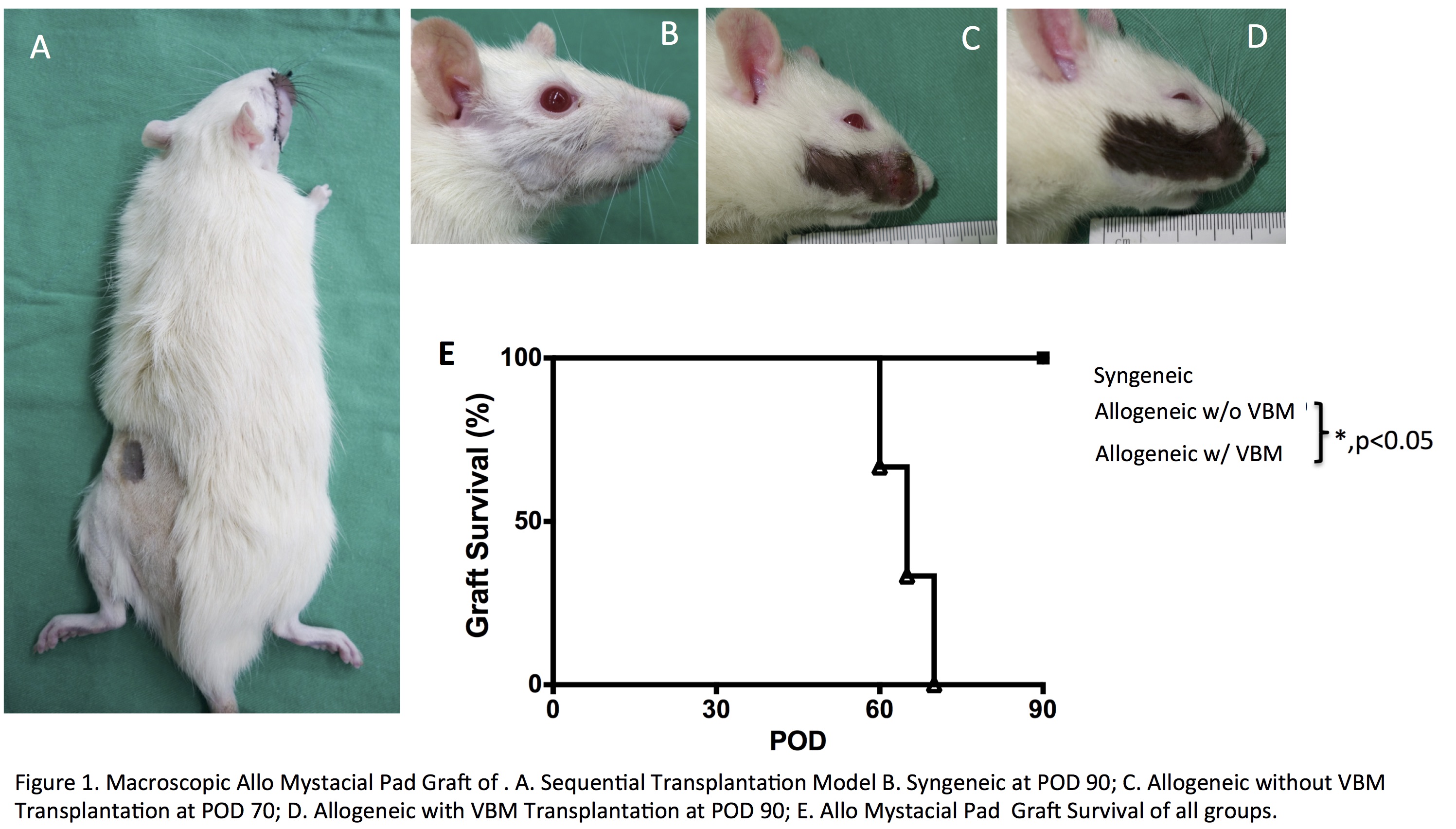Functional Mystacial Pad Allograft Tolerance Induced and Maintained by Vascularized Bone Marrow Transplant.
1Department of PRS, Center for Vascularized Composite Allotransplantation, Chang Gung Memorial Hospital, Taoyuan, Taiwan
2Chang Gung Medical College and Chang Gung University, Taoyuan, Taiwan
3Department of Pathology, Chang Gung Memorial Hospital, Taoyuan, Taiwan
4Department of Plastic and Reconstructive Surgery, Johns Hopkins University School of Medicine, Baltimore, MD
Meeting: 2017 American Transplant Congress
Abstract number: C292
Keywords: Alloantigens, Bone marrow, FK506, Nerve allografts
Session Information
Session Name: Poster Session C: Tolerance/Immune Regulation
Session Type: Poster Session
Date: Monday, May 1, 2017
Session Time: 6:00pm-7:00pm
 Presentation Time: 6:00pm-7:00pm
Presentation Time: 6:00pm-7:00pm
Location: Hall D1
Background: Accumulating findings indicate that vascularized bone marrow (VBM) transplantation plays a critical role to promote tolerance of vascularized composite allografts (VCA) without life-long immunosuppression. We hypothesize that VBM may induce secondary rat mystacial pad allograft tolerance and functional outcome can be restored.
Method: Thirty transplants includes VBM allografts, mystacial pad allografts, and sequential VBM and mystacial pad allografts from Brown-Norway (BN) rats were performed onto Lewis (Lew) rats and antilymphocyte serum (ALS) followed by 7 days (D) of 2mg/kg/day of Tacrolimus (Tac) and 3mg/kg/day for 3 weeks (W) of rapamycin (RPM) were administered. Long-term allograft survival, donor-specific tolerance as well as chimerism level were evaluated. A secondary full-thickness skin transplant from both BN and Sprague-Dawley (SD) strains was performed when the vascularized hind-limb transplant survived >90 days.
Results: Under ALS and combination of short-term Tac and RPM treatment, animals received VBM showed long-term graft survival (>120 days) with chimerism persisted for 30 days but then declined long-term. Tolerant rats showed CD3+ T cells donor-specific hyporesponsiveness and tolerance to donor-specific skin graft, but not to allo third-party skin grafts. Interestingly, in the animals received same immunosuppressive regimen, long-term mystacial pad graft tolerance was only maintained in the presence of VBM (MST >90 days vs MST= 70 days).  Moreover, those animals presented good whiskering and functional recovery.
Moreover, those animals presented good whiskering and functional recovery.
Conclusion: Efficacy of VBM transplantation to induce long-term secondary mystacial pad allograft survival has been shown in this study. Mystacial pad allograft in which nerves were repaired showed functional recovery.
CITATION INFORMATION: Lin C.-H, Anggelia M, Wen C.-J, Chuang W.-Y, Cheng H.-Y, Lin C.-H, Brandacher G. Functional Mystacial Pad Allograft Tolerance Induced and Maintained by Vascularized Bone Marrow Transplant. Am J Transplant. 2017;17 (suppl 3).
To cite this abstract in AMA style:
Lin C-H, Anggelia M, Wen C-J, Chuang W-Y, Cheng H-Y, Lin C-H, Brandacher G. Functional Mystacial Pad Allograft Tolerance Induced and Maintained by Vascularized Bone Marrow Transplant. [abstract]. Am J Transplant. 2017; 17 (suppl 3). https://atcmeetingabstracts.com/abstract/functional-mystacial-pad-allograft-tolerance-induced-and-maintained-by-vascularized-bone-marrow-transplant/. Accessed December 24, 2025.« Back to 2017 American Transplant Congress
